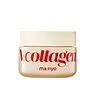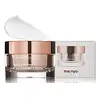What's inside
What's inside
 Key Ingredients
Key Ingredients

 Benefits
Benefits

 Concerns
Concerns

 Ingredients Side-by-side
Ingredients Side-by-side

Collagen Extract 36%
Skin ConditioningWater
Skin ConditioningPropanediol
SolventGlycerin
HumectantAcetylated Hydrogenated Vegetable Glyceride
EmollientHydrogenated Poly(C6-14 Olefin)
EmollientNiacinamide
SmoothingHelianthus Annuus Seed Oil
Emollient1,2-Hexanediol
Skin ConditioningAmmonium Acryloyldimethyltaurate/Vp Copolymer
Tremella Fuciformis Extract
HumectantLupinus Albus Seed Extract
Skin ConditioningLeuconostoc/Radish Root Ferment Filtrate
AntimicrobialRosa Damascena Flower Oil
MaskingRosa Damascena Flower Water
MaskingCollagen
MoisturisingButylene Glycol
HumectantTocopherol
AntioxidantLecithin
EmollientPentylene Glycol
Skin ConditioningSorbitan Olivate
EmulsifyingCetearyl Olivate
Cetyl Alcohol
EmollientStearyl Alcohol
EmollientCetearyl Alcohol
EmollientSynthetic Beeswax
Emulsion StabilisingPolyglyceryl-3 Methylglucose Distearate
EmulsifyingSodium Polyacrylate
AbsorbentCaramel
Cosmetic ColorantGluconolactone
Skin ConditioningDisodium EDTA
Ethylhexylglycerin
Skin ConditioningSodium Hydroxide
BufferingPelargonium Graveolens Flower Oil
MaskingAdenosine
Skin ConditioningCitronellol
PerfumingGeraniol
PerfumingLinalool
PerfumingCollagen Extract 36%, Water, Propanediol, Glycerin, Acetylated Hydrogenated Vegetable Glyceride, Hydrogenated Poly(C6-14 Olefin), Niacinamide, Helianthus Annuus Seed Oil, 1,2-Hexanediol, Ammonium Acryloyldimethyltaurate/Vp Copolymer, Tremella Fuciformis Extract, Lupinus Albus Seed Extract, Leuconostoc/Radish Root Ferment Filtrate, Rosa Damascena Flower Oil, Rosa Damascena Flower Water, Collagen, Butylene Glycol, Tocopherol, Lecithin, Pentylene Glycol, Sorbitan Olivate, Cetearyl Olivate, Cetyl Alcohol, Stearyl Alcohol, Cetearyl Alcohol, Synthetic Beeswax, Polyglyceryl-3 Methylglucose Distearate, Sodium Polyacrylate, Caramel, Gluconolactone, Disodium EDTA, Ethylhexylglycerin, Sodium Hydroxide, Pelargonium Graveolens Flower Oil, Adenosine, Citronellol, Geraniol, Linalool
Bifida Ferment Lysate 62%
Skin ConditioningButylene Glycol
HumectantCaprylic/Capric Triglyceride
MaskingCetyl Ethylhexanoate
EmollientGlycerin
HumectantSqualane
EmollientNiacinamide
Smoothing1,2-Hexanediol
Skin ConditioningCetearyl Alcohol
EmollientPolyglyceryl-2 Stearate
EmulsifyingCutibacterium Granulosum Ferment Extract Filtrate
EmollientCoco-Caprylate/Caprate
EmollientLactobacillus/Pumpkin Fruit Ferment Filtrate
Skin ConditioningAureobasidium Pullulans Ferment
Skin ConditioningBetaine
HumectantPanthenol
Skin ConditioningAcetyl Hexapeptide-8
HumectantPalmitoyl Tripeptide-1
Skin ConditioningCopper Tripeptide-1
Skin ConditioningSh-Polypeptide-1
Skin ConditioningSh-Oligopeptide-1
Skin ConditioningGlyceryl Stearate
EmollientStearyl Alcohol
EmollientPolyglyceryl-3 Methylglucose Distearate
EmulsifyingCeramide NP
Skin ConditioningCeramide AP
Skin ConditioningCeramide As
Skin ConditioningCeramide Ns
Skin ConditioningCeramide EOP
Skin ConditioningEpigallocatechin Gallate
AntioxidantGlyceryl Stearate Se
EmulsifyingSorbitan Stearate
EmulsifyingDipropylene Glycol
HumectantIsopropyl Myristate
EmollientSodium Carbomer
Emulsion StabilisingHydroxyethyl Acrylate/Sodium Acryloyldimethyl Taurate Copolymer
Emulsion StabilisingGlyceryl Caprylate
EmollientSodium Hyaluronate
HumectantHydroxypropyltrimonium Hyaluronate
Hydrolyzed Hyaluronic Acid
HumectantPotassium Hyaluronate
Skin ConditioningHydrolyzed Sodium Hyaluronate
Skin ConditioningSodium Hyaluronate Crosspolymer
HumectantHyaluronic Acid
HumectantSodium Acetylated Hyaluronate
HumectantWater
Skin ConditioningEthylhexylglycerin
Skin ConditioningScutellaria Baicalensis Root Extract
AstringentPanax Ginseng Callus Culture Extract
Skin ConditioningPanax Ginseng Root Extract
EmollientHydrogenated Lecithin
EmulsifyingPhytosphingosine
Skin ConditioningCholesterol
EmollientHydrolyzed Algin
Stearic Acid
CleansingPhysalis Alkekengi Fruit Extract
Skin ConditioningFoeniculum Vulgare Fruit Extract
EmollientPhosphatidylcholine
EmulsifyingIllicium Verum Fruit Extract
PerfumingCaramel
Cosmetic ColorantDextrin
AbsorbentRosa Damascena Flower Oil
MaskingCaffeine
Skin ConditioningAdenosine
Skin ConditioningBifida Ferment Lysate 62%, Butylene Glycol, Caprylic/Capric Triglyceride, Cetyl Ethylhexanoate, Glycerin, Squalane, Niacinamide, 1,2-Hexanediol, Cetearyl Alcohol, Polyglyceryl-2 Stearate, Cutibacterium Granulosum Ferment Extract Filtrate, Coco-Caprylate/Caprate, Lactobacillus/Pumpkin Fruit Ferment Filtrate, Aureobasidium Pullulans Ferment, Betaine, Panthenol, Acetyl Hexapeptide-8, Palmitoyl Tripeptide-1, Copper Tripeptide-1, Sh-Polypeptide-1, Sh-Oligopeptide-1, Glyceryl Stearate, Stearyl Alcohol, Polyglyceryl-3 Methylglucose Distearate, Ceramide NP, Ceramide AP, Ceramide As, Ceramide Ns, Ceramide EOP, Epigallocatechin Gallate, Glyceryl Stearate Se, Sorbitan Stearate, Dipropylene Glycol, Isopropyl Myristate, Sodium Carbomer, Hydroxyethyl Acrylate/Sodium Acryloyldimethyl Taurate Copolymer, Glyceryl Caprylate, Sodium Hyaluronate, Hydroxypropyltrimonium Hyaluronate, Hydrolyzed Hyaluronic Acid, Potassium Hyaluronate, Hydrolyzed Sodium Hyaluronate, Sodium Hyaluronate Crosspolymer, Hyaluronic Acid, Sodium Acetylated Hyaluronate, Water, Ethylhexylglycerin, Scutellaria Baicalensis Root Extract, Panax Ginseng Callus Culture Extract, Panax Ginseng Root Extract, Hydrogenated Lecithin, Phytosphingosine, Cholesterol, Hydrolyzed Algin, Stearic Acid, Physalis Alkekengi Fruit Extract, Foeniculum Vulgare Fruit Extract, Phosphatidylcholine, Illicium Verum Fruit Extract, Caramel, Dextrin, Rosa Damascena Flower Oil, Caffeine, Adenosine
 Reviews
Reviews

Ingredients Explained
These ingredients are found in both products.
Ingredients higher up in an ingredient list are typically present in a larger amount.
1,2-Hexanediol is a synthetic liquid and another multi-functional powerhouse.
It is a:
- Humectant, drawing moisture into the skin
- Emollient, helping to soften skin
- Solvent, dispersing and stabilizing formulas
- Preservative booster, enhancing the antimicrobial activity of other preservatives
Adenosine is in every living organism. It is one of four components in nucleic acids that helps store our DNA.
Adenosine has many benefits when used. These benefits include hydrating the skin, smoothing skin, and reducing wrinkles. Once applied, adenosine increases collagen production. It also helps with improving firmness and tissue repair.
Studies have found adenosine may also help with wound healing.
In skincare products, Adenosine is usually derived from yeast.
Learn more about AdenosineButylene Glycol (or BG) is used within cosmetic products for a few different reasons:
Overall, Butylene Glycol is a safe and well-rounded ingredient that works well with other ingredients.
Though this ingredient works well with most skin types, some people with sensitive skin may experience a reaction such as allergic rashes, closed comedones, or itchiness.
Learn more about Butylene GlycolWe don't have a description for Caramel yet.
Cetearyl alcohol is a mixture of two fatty alcohols: cetyl alcohol and stearyl alcohol. It is mainly used as an emulsifier. Emulsifiers help prevent the separation of oils and products. Due to its composition, it can also be used to thicken a product or help create foam.
Cetearyl alcohol is an emollient. Emollients help soothe and hydrate the skin by trapping moisture.
Studies show Cetearyl alcohol is non-toxic and non-irritating. The FDA allows products labeled "alcohol-free" to have fatty alcohols.
This ingredient is usually derived from plant oils such as palm, vegetable, or coconut oils. There is debate on whether this ingredient will cause acne.
Due to the fatty acid base, this ingredient may not be Malassezia folliculitis safe.
Learn more about Cetearyl AlcoholEthylhexylglycerin (we can't pronounce this either) is commonly used as a preservative and skin softener. It is derived from glyceryl.
You might see Ethylhexylglycerin often paired with other preservatives such as phenoxyethanol. Ethylhexylglycerin has been found to increase the effectiveness of these other preservatives.
Glycerin is already naturally found in your skin. It helps moisturize and protect your skin.
A study from 2016 found glycerin to be more effective as a humectant than AHAs and hyaluronic acid.
As a humectant, it helps the skin stay hydrated by pulling moisture to your skin. The low molecular weight of glycerin allows it to pull moisture into the deeper layers of your skin.
Hydrated skin improves your skin barrier; Your skin barrier helps protect against irritants and bacteria.
Glycerin has also been found to have antimicrobial and antiviral properties. Due to these properties, glycerin is often used in wound and burn treatments.
In cosmetics, glycerin is usually derived from plants such as soybean or palm. However, it can also be sourced from animals, such as tallow or animal fat.
This ingredient is organic, colorless, odorless, and non-toxic.
Glycerin is the name for this ingredient in American English. British English uses Glycerol/Glycerine.
Learn more about GlycerinNiacinamide is a multitasking form of vitamin B3 that strengthens the skin barrier, reduces pores and dark spots, regulates oil, and improves signs of aging.
And the best part? It's gentle and well-tolerated by most skin types, including sensitive and reactive skin.
You might have heard of "niacin flush", or the reddening of skin that causes itchiness. Niacinamide has not been found to cause this.
In very rare cases, some individuals may not be able to tolerate niacinamide at all or experience an allergic reaction to it.
If you are experiencing flaking, irritation, and dryness with this ingredient, be sure to double check all your products as this ingredient can be found in all categories of skincare.
When incorporating niacinamide into your routine, look out for concentration amounts. Typically, 5% niacinamide provides benefits such as fading dark spots. However, if you have sensitive skin, it is better to begin with a smaller concentration.
When you apply niacinamide to your skin, your body converts it into nicotinamide adenine dinucleotide (NAD). NAD is an essential coenzyme that is already found in your cells as "fuel" and powers countless biological processes.
In your skin, NAD helps repair cell damage, produce new healthy cells, support collagen production, strengthen the skin barrier, and fight environmental stressors (like UV and pollution).
Our natural NAD levels start to decline with age, leading to slower skin repair, visible aging, and a weaker skin barrier. By providing your skin niacinamide, you're recharging your skin's NAD levels. This leads to stronger, healthier, and younger looking skin.
Another name for vitamin B3 is nicotinamide. This vitamin is water-soluble and our bodies don't store it. We obtain Vitamin B3 from either food or skincare. Meat, fish, wheat, yeast, and leafy greens contain vitamin B3.
The type of niacinamide used in skincare is synthetically created.
Learn more about NiacinamidePolyglyceryl-3 Methylglucose Distearate is created from the diester of stearic acid and the condensation product of methylglucose and Polyglycerin-3.
As an emulsifier, it is used to bind ingredients together. Many ingredients, such as oils and water, separate naturally. Emulsifiers prevent them from separating to ensure even consistency in texture.
One of the manufacturer for this ingredient states it is vegetable-based. It is also claimed to be stable at both high and low temperatures.
This ingredient may not be safe for fungal acne. We recommend speaking with a professional if you have any concerns.
Learn more about Polyglyceryl-3 Methylglucose DistearateRosa Damascena Flower Oil is an essential oil made from the Damask Rose. It is often used as a fragrance in cosmetics.
Rose Oil has antibacterial and antioxidant properties due to its terpene, glycoside, flavonoid, anthocyanin, and Vitamin C content.
Other major parts of Rose Oil include citronellol and geraniol. Both of these are known EU allergens and cause contact-allergies.
The downsides of this ingredient outweight the positives.
Learn more about Rosa Damascena Flower OilStearyl Alcohol is a type of fatty alcohol from stearic acid. It is a white, waxy compound used to emulsify ingredients.
Fatty Alcohols are most often used as an emollient or to thicken a product. Emollients help soothe and hydrate the skin by trapping moisture.
They are usually derived from natural fats and oils and therefore do not have the same drying or irritating effect as solvent alcohols. FDA allows products labeled "alcohol-free" to have fatty alcohols.
Learn more about Stearyl AlcoholWater. It's the most common cosmetic ingredient of all. You'll usually see it at the top of ingredient lists, meaning that it makes up the largest part of the product.
So why is it so popular? Water most often acts as a solvent - this means that it helps dissolve other ingredients into the formulation.
You'll also recognize water as that liquid we all need to stay alive. If you see this, drink a glass of water. Stay hydrated!
Learn more about Water